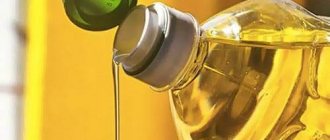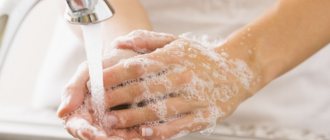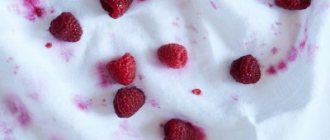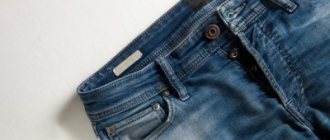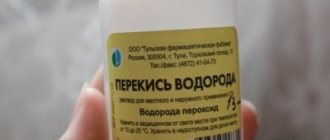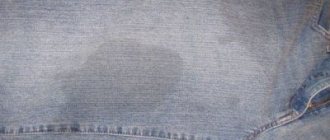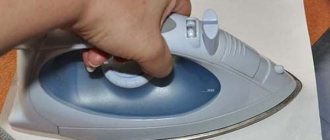How to properly wash sunflower oil from clothes at home. Mothers and grandmothers considered such spots practically invincible. Fortunately, over time, housewives learned to deal with them. Today there are many simple methods using available tools.
The difficulty in removing stains from vegetable oils is that they do not dissolve in water. Such contaminants can be effectively combated only at high temperatures or by pre-treatment with a substance that dissolves fat molecules. It is important to consider the type of fabric and the durability of the mark itself.
- How to remove traces of vegetable oil
- Proven means
- Subtleties when working with different materials
- Removing old stains
- Removing butter
- Expert advice
How to remove traces of vegetable oil
Vegetable oil stains, like any other stains, are easier to remove while they are fresh, so you need to act immediately. Timely measures taken are the key to success. What to do:
- Wetting its outer edges with cool water will help prevent contamination from spreading.
- The newly created stain should be blotted with a paper napkin without rubbing it. This will prevent oil from penetrating deep into the fibers of the fabric.
- The remaining mark must be treated with dishwashing detergent, applying it with patting movements, rubbing in, but not smearing. This should be done with your fingertips from the edges to the center.
Expert opinion
Irina. Housewife.
Ask a Question
Important! Timely measures will help remove the oil stain quickly, without damaging the fabric.
Proven means
Salt
Kitchen salt has the ability to absorb liquid. Sprinkle it generously on the stain, and after 15-20 minutes shake it off and replace it with a new one. Then the item is washed in the usual way.
Important! This approach is suitable for any type of fabric, including delicate ones.
Dishwashing liquid
Dishwashing detergents, such as “Fairy”, “Gala Cold Power” and others with grease-dissolving components, successfully cope with any oil stains on all types of fabrics.
In their pure form, they are generously applied to the dirt and left for 30-60 minutes. After which the item must be washed in the usual way. This method is suitable for all types of fabrics and clothing, including carpets and upholstery.
Important! If there is a large area of dirt, the entire item must be soaked in a solution of dishwashing detergent and water.
Mustard powder
Dark things can be saved with mustard powder.
It is diluted until a homogeneous and thick mass is obtained. The composition is applied to the contaminated area for 40-60 minutes until completely dry. Then you need to shake it off and wash the product in the washing machine.
Important! This method is only suitable for dark things, since mustard tends to stain fabrics.
Soda
It is successfully used to clean grease and other contaminants from surfaces.
There are no contraindications to using soda for different types of fabrics. It should be sprinkled generously on the stain and left to act for 1-1.5 hours. Then you need to shake it off and evaluate the result. If necessary, repeat the procedure.
Gasoline and other solvents
A method known to everyone for many years and successfully used for removing oil stains is the use of purified gasoline.
The liquid is applied to the contaminated area with a cotton pad or sponge using blotting movements. After weathering and drying, the item should be washed as usual.
Stain remover
Preference should be given to special stain removers that are effective in combating greasy stains. They are used strictly according to the instructions.
Washing powder or soap
In most cases, neither soap nor laundry detergents can remove oil stains. Because they do not contain components that effectively dissolve fat molecules. They are used at the final stage, when the oil stain has already been removed.
Using starch
For delicate fabrics, use corn or potato starch.
You will need 2 more white napkins or kitchen towels and a hot iron heated to the temperature that is acceptable for this type of material. The product at the site of contamination must be moistened. The item is placed on the wrong side, previously sprinkled with starch. On the other hand, you need to do a similar action. Then the “structure” is ironed several times.
After this, you need to remove the napkins, shake off the starch and evaluate the result. Repeat if necessary. Wash the item as usual.
Plumbing cleaning products
Any kitchen surface cleaner will do.
It must be diluted with lukewarm water in equal proportions. Then the solution is applied to the stain and left for 20-30 minutes. After achieving the desired result, the item must be rinsed thoroughly.
Expert opinion
Irina. Housewife.
Ask a Question
Important! Use this method exclusively for resistant fabrics. It is contraindicated for delicate products. Before you start using the product, you need to test its effect on an inconspicuous area of the item.
Ammonia and turpentine
Turpentine and ammonia are combined in equal proportions, after which they must be diluted 1:1 with warm water. The mixture is applied to the oil trail with a sponge. Then, you need to wait about 20 minutes. Then the item should be washed.
Glycerol
It can be purchased at your nearest pharmacy.
A bottle of glycerin is immersed in warm (50-60 degrees) water for 20 minutes. Then the area of fabric stained with oil is soaked in the product and left to act for about an hour. After that, the area should be blotted with a napkin and the item should be washed.
Dentifrice
A practical housewife should always have it at hand.
Despite the fact that it has long been replaced by toothpaste, which is less abrasive, many household problems are solved with the help of tooth powder. It is diluted with warm water to a paste-like state and the solution is treated with a rubbing motion. After waiting 10-15 minutes, the paste should be washed off and the effect assessed. Repeat if necessary.
Important! This method will not damage delicate tissues.
Chalk
It has good absorbent properties.
Chalk effectively absorbs oil components. In addition, it is not capable of damaging delicate and delicate tissues. To remove a greasy stain with chalk, grind it to a powder and apply for 1.5-2 hours. As an alternative, it is permissible to use the method with an iron and napkins.
Important! You can replace chalk with Calcium gluconate tablets.
Shaving foam
It is successfully used for various types of fabrics as a vegetable oil stain remover.
It contains components that effectively dissolve fats. Expert opinion
Irina. Housewife.
Ask a Question
Important! Use foam. The gel has other components.
The bottle must be shaken before use and foam should be applied liberally to the stain and left for 20-30 minutes. Then blot with a clean and dry cloth, and then rinse with water. This procedure can be carried out several times without fear of damaging the product.
Important! This method is ideal for carpets and furniture upholstery.
White clay with vinegar
A mixture of vinegar and cosmetic white clay can successfully remove fresh and old greasy stains.
Clay can be purchased at cosmetics and household chemical stores. It is diluted with table vinegar to a thick paste. Then the mixture is applied to the contaminated area.
It should be left until completely dry. Residues should be shaken off or cleaned depending on the type of fabric.
Cleansing from animal oils
A variety of textile products get stains from pork or beef fat, butter, and canned fish. The fight against them should begin immediately.
Available methods:
- Having found sprat oil on the jacket, dilute dish gel - 1.5 tbsp. l. in warm water - 200 ml. Soak a piece of soft rag and wipe off the dirt. The remains are washed off with a sponge moistened in cool water and a terry towel is placed on top to absorb excess moisture. If washing is allowed, then do it as usual.
- Refined gasoline diluted 1:1 with water can remove butter or fat from jeans. Oily streaks are moistened with the solution and lightly rubbed off.
- Grated white soap will help remove old stains from a shirt. It is stirred in gasoline until completely dissolved, maintaining a ratio of 1:10. Soak greasy deposits for two hours. Then, before washing, wipe the treated area with a cotton pad soaked in gasoline.
- Ammonia will clean a towel or tablecloth of animal fats. Apply it to the stains using a light textile napkin, leaving for 30 minutes. This method is acceptable for black items.
- The T-shirt will be free of grease marks if they are still fresh. Take a cotton swab, dip it in nail liquid and apply it liberally to the affected tissue. The main wash is due in 20 minutes. The method is not used for synthetics.
- Cotton white items effectively regain their former freshness if you pour 5 liters of water into a pan, add 3 tbsp. l. stain remover "Vanish". Immerse the products and boil at medium heat for 10 minutes, turning periodically using a wooden stirrer.
- If the blouse is made of thin fabric that requires delicate handling, then before washing it is soaked for 20 minutes in warm water with a small amount of stain remover.
ARTICLE FOR YOU
How and with what to wash and remove fuel oil stains from clothes and linen
Cleansing from animal oils
Often a piece of butter ends up on a sofa, carpet, armchair, rug. In such a situation, first scrape off the bulk with a blunt object. Movements should be smooth so as not to press dirt into the fibers. Then pour a thick layer of soda.
If necessary, replace it several times with a fresh portion until all traces disappear. Residues are removed with a brush or the surface is vacuumed.
Subtleties when working with different materials
The cleaning method must be selected taking into account the type of product and material. Different substances behave differently on different types of tissue.
Jeans
Denim quickly absorbs vegetable oil. Contaminants instantly penetrate the fibers. Therefore, to remove oils from denim, soaking methods are suitable, the time of which should be increased. The advantage is that these products can be washed at high temperatures, which dissolve oils.
Raincoat
Jackets, bags and other items made from raincoat fabric are processed using any cold method. It is preferable to use dishwashing detergent. Initially, it is applied to the stain for a long-term effect of 1-2 hours. Then, the entire thing is soaked in it for 3-4 hours.
Knitwear
T-shirts most often suffer from vegetable oil getting on them.
Knitted items will not tolerate exposure to high temperatures and aggressive detergents. Preference should be given to gentle methods followed by soaking and washing. Do you wash by hand?
Oh yes! No
Carpets and upholstery
The difficulty in removing stains from these surfaces is that they cannot be washed or soaked. Therefore, it is preferable to use dry cleaning methods - soda, chalk, tooth powder or shaving foam (see above).
After the stain is removed, the remaining product is removed using a vacuum cleaner. The carpet or upholstery should then be cleaned completely with a damp brush and soap.
Expert opinion
Irina. Housewife.
Ask a Question
Important! It is easier to treat furniture upholstery or flooring if you have a steam cleaner. A washing vacuum cleaner also works great.
Trousers
An item of clothing on which traces of oils appear more often than on others and the reason for this is carelessness while eating. Problems with removal will not arise if fresh contamination is sprinkled with salt or soda, as in the above method.
Salt
Fighting cosmetic oil stains
Clothing gets contaminated when using oily substances for cosmetic and health purposes - massage, face and skin masks, wraps. Stains after such procedures appear on various items of clothing, carpeting, and bed linen.
Massage Oil
Marks from the massage oily substrate have to be removed from both clothing and sheets. White fabric is soaked in hydrogen peroxide. After three hours the item can be washed.
After a massage, remove marks from colored items using soda and salt. Take these products 1 tbsp. l. and dissolve in 2 liters of warm water. The product is immersed completely or only the dirty part. After an hour, thoroughly wash the remaining prints by hand using laundry soap.
Antipyatin soap
Having discovered not only characteristic stains on children's things a few days after the massage, but also a rancid odor of oil, moisten all contaminated areas and thoroughly rub with a bar of Antipyatin soap. Place in an enamel basin, covered with film, for two hours. Then add a little warm water and wash by hand.
Essential oil
One of the common components of anti-aging masks is ether. If specks from this substance are found on a light-colored blouse, use tooth powder without coloring additives. The cloth is moistened, powder is poured in and all dirt is removed with a brush.
Fresh spray is blotted and sprinkled with talcum powder, rubbing it with a brush for no longer than five minutes. Brush off the residue, carefully drip liquid soap and continue scrubbing the print with a brush, rinse with clean water and machine wash. If outerwear is being cleaned, the dirt particles are washed off with a damp sponge.
Vaseline oil
Vaseline oil
To remove streaks that Vaseline oil left on things, you need to moisten them with WD-40 aerosol. Then put a layer of soda on top and wipe with a brush. After shaking off the particles, soak a soft cloth in dishwashing liquid and remove any remaining oil.
ARTICLE FOR YOU
How and with what to wash, remove unpleasant odors and urine stains from clothes and linen
Using the same method, paraffin oils are removed from textiles.
Tanning oil
Towels, sundresses, shorts, blouses, soaked in the tanning oil remaining on the skin, become dirty and covered with noticeable stains.
It is possible to wash them if you first prepare a solution from ammonia, to which dishwashing gel and soda are added in equal parts. Apply the mixture to the treated area for 15 minutes. Place cotton wool soaked in ammonia. After 10 minutes, pour in soda and wipe off all oily traces with your hands.
Ammonia
Expert advice
To remove a greasy stain without damaging the product, you must adhere to the following recommendations:
- Any substance can only be used if it is safe for the fabric on which it will be used. Before proceeding to the treatment of the entire item, the product should be tested on an inconspicuous area of the product.
- There is no need to try to remove fat from the fabric by drying it, this will complicate the stain removal.
- The product must be processed by placing it on a washable surface, diaper or napkin. You should not do this on the sofa or carpet. There is a high probability that oil will stain the surface under the item.
- You should not increase the proportions of aggressive detergent components; it is better to repeat the procedure several times if necessary.
- Some items, such as suede and leather, are best taken to dry cleaning.
In fact, it is not difficult to wash sunflower or other vegetable oil from clothes. It will take a little time, effort and persistence.
